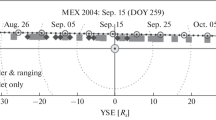Abstract
SYSTEMATIC study of horizontal movements in the ionosphere has been made during the past few years by using the spaced-transmitter technique developed by Munro1, which is applicable only for the F2 region, and the spaced-receiver method first employed by Mitra3. However, both these methods require elaborate and expensive ionospheric pulse-sounding equipment. We present here a simple method of studying winds in the ionosphere using continuous-wave transmissions and a simple receiver with a recording system.
Similar content being viewed by others
References
Munro, G. H., Nature, 162, 886 (1948); Proc. Roy. Soc., A, 202, 208 (1950).
Mitra, S. N., Proc. Inst. Elec. Eng., III, 96, 441 (1949).
Author information
Authors and Affiliations
Rights and permissions
About this article
Cite this article
RAO, B., MURTY, D. A Simple Method of studying Winds in the Ionosphere by using Continuous-wave Radio. Nature 177, 1222–1223 (1956). https://doi.org/10.1038/1771222a0
Issue Date:
DOI: https://doi.org/10.1038/1771222a0
- Springer Nature Limited




